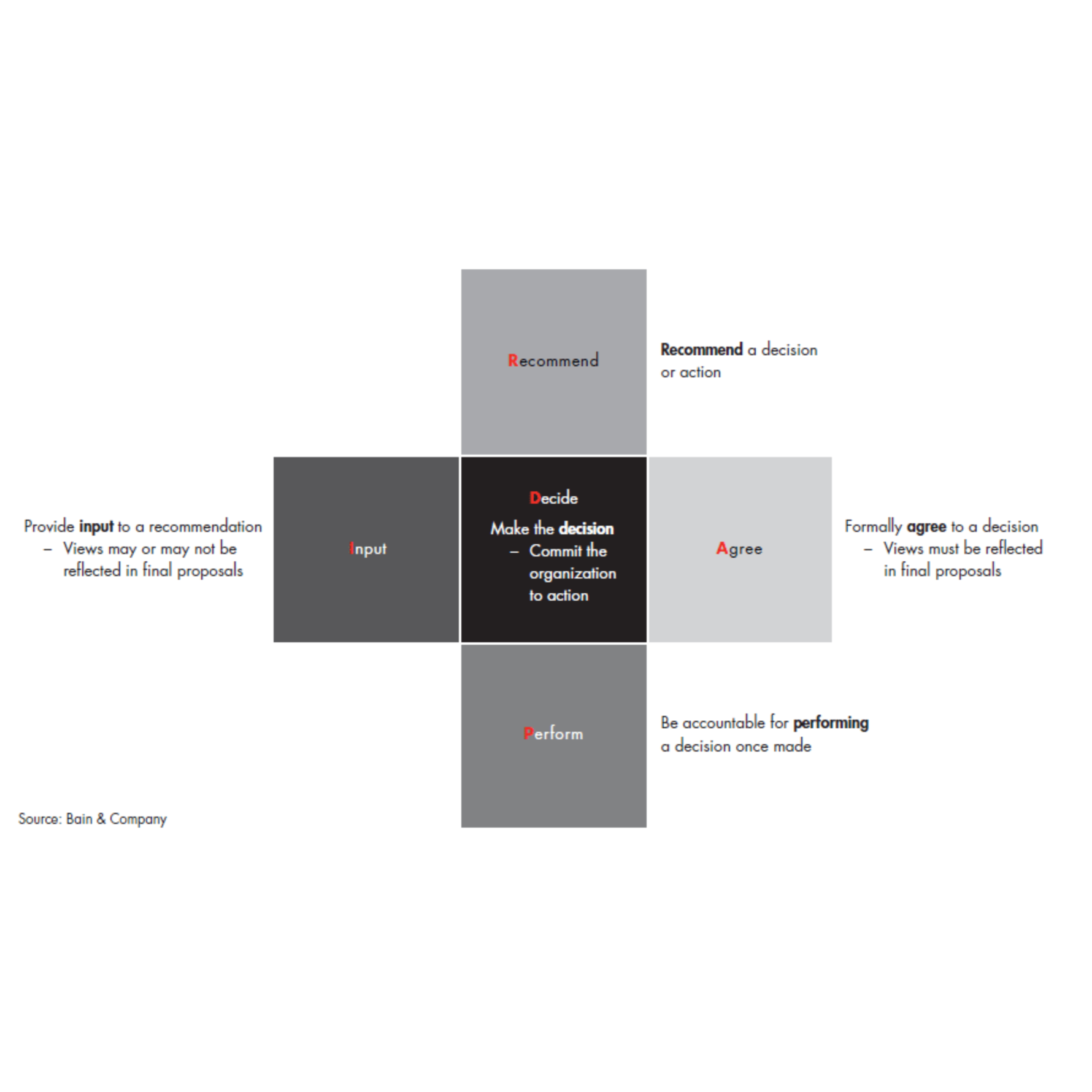RAPID Decision Making
As a professional decision maker, I have spent my life studying how to make decisions effectively and have constantly looked for rules and systems that will improve my odds of being right and ending up with more of whatever it is that I am after. (1/2) #principleoftheday pic.twitter.com/DqavlaFcG0
— Ray Dalio (@RayDalio) August 25, 2022
In Ray We Trust...
Decision making is one of the most important skills you can develop – personally or professionally – because the sum of the decisions you (or your organization) make determine the success or failure of the next few months, quarters, etc.
But not every decision should be made the same way and one of the hardest things to get right is the level of speed vs. rigor and time spent on decisions. So having a number of different frameworks or ways to make decisions is important.
Quite a few decision making frameworks are out there that I'll likely touch on in the future. Some (e.g. Tim Ferris' Fear Setting) are geared more toward personal decisions and others are applicable in a business or team setting.
My Experience with RAPIDs
Archive is a software company I helped start in early 2020 and we scaled pretty fast. We were fully remote & globally distributed with the majority of our headcount in Eastern Europe and Asia Pacific.
From a management perspective we empowered people to own decisions but hit a point where leadership was a bit of a bottleneck at a time where we were doubling down on speed as a key execution habit.
We wanted to continue making high quality decisions while ensuring the decisions made in the org supported our values & principles as a company. So we leveraged existing frameworks and adapted them to support our company and style.
One important guiding reference was Amazon’s Type 1 vs. Type 2 decision categorization – it helped us quickly sort out the level of rigor to use...
A Jeff Bezos snippet from the 1997 shareholder report
…one common pitfall for large organizations – one that hurts speed and inventiveness – is “one-size-fits-all” decision making.
Some decisions are consequential and irreversible or nearly irreversible – one-way doors – and these decisions must be made methodically, carefully, slowly, with great deliberation and consultation. If you walk through and don’t like what you see on the other side, you can’t get back to where you were before. We can call these Type 1 decisions. But most decisions aren’t like that – they are changeable, reversible – they’re two-way doors. If you’ve made a suboptimal Type 2 decision, you don’t have to live with the consequences for that long. You can reopen the door and go back through. Type 2 decisions can and should be made quickly by high judgment individuals or small groups.
As organizations get larger, there seems to be a tendency to use the heavy-weight Type 1 decision-making process on most decisions, including many Type 2 decisions. The end result of this is slowness, unthoughtful risk aversion, failure to experiment sufficiently, and consequently diminished invention.1 We’ll have to figure out how to fight that tendency.
And one-size-fits-all thinking will turn out to be only one of the pitfalls. We’ll work hard to avoid it… and any other large organization maladies we can identify.
From there we used RAPID for Type 1 and more complex Type 2 decisions and Problem / Proposed Solutions (P/PS) from Matt Mochary for lighter weight items. Both helped foster a faster, stronger decision making culture.
What is (a) RAPID?
RAPID is actually a registered trademark of Bain. In short, it's a tool/framework for embedding accountability into decision making especially when companies hit a point where it's tough to get all stakeholders "in the same room".
It defines roles & responsibilities required for making larger more complex decisions that may or may not end up in a larger implementation project. Put simply, it gets alignment on important direction when multiple options exist.
Here are the roles which make up the acronym itself. More on these roles in my RAPID template which you can get on the Free tab.
| Letter | Role |
|---|---|
| R | Recommend |
| A | Agree |
| P | Perform |
| I | Input |
| D | Decision |
Why is RAPID valuable?
RAPID improves quality and speed of decision making over time but the most powerful value add is often overlooked: the impact on culture.
I like Ben Horowitz's idea that culture is programmed. Most people think that once you get values up on a wall or on the website, it's a wrap, you've got a great culture. But the reality is that culture is always moving & fluctuating. Why? Because it's consistent action in accordance with standards that define culture and act as the guardrails for keeping your culture on the ideal track you've laid out with values. You're constantly bringing on new people, training them, etc. Actions will never be 100% in accordance with culture.
Decisions present one of the most powerful ways to establish and reinforce culture. The way you make decisions determines your actions and can either promote, or detract, from the culture you desire. A strong decision making culture can help foster a lot of what many startups want to embrace in their overall culture: speed, quality, ownership & accountability, transparency and continuous learning.
How Do RAPID Do This?
I want to be concise here and I think it comes down to two ideas.
First, documentation is fucking powerful. It's required for scale, clarifies ownership and accountability, etc. I view documentation in two buckets:
- Standard Operating Procedures (SOPs) - or simply "Process Docs". Any time something is done more than 1x it must be documented and centralized publicly. This makes hiring, training, and unlocking delegation possible at scale and becomes a reference point for continuous improvement.
- Collaborative Documentation - when it comes to decisions, memos, meeting notes, project docs, business cases, etc. everything should be housed publicly. A key feature of these templates should be properties for ownership of the doc, status of the doc and especially next steps + owners + due-dates.
So, you're going to make a lot of decisions and you want to scale. Why wouldn't you document your decision making process. Even if you're not using RAPID, get it written down, and you're already ahead of the curve.
Second, key features of RAPID lead to speed & quality over time.
- Volume: the best way to improve X is to do more of it. A documented process enables more people in your org to own & contribute to more decisions.
- Transparency: public decision making gives your org visibility into how decisions are made (good & bad) thus improving learning & reinforcing culture.
- Ownership & Accountability: you have very clear and agreed upon owners, roles, deadlines, etc.
- Trackability: documented decisions are easy to track, like a project, in a couple of ways. A good RAPID process starts painting a clear picture of what implementation will look like, who owns it and when it needs to happen. Second, documented & centralized decisions can be tagged, categorized, reviewed, postmortem'd and act as references for the next feature.
- Learning: transparent, trackable decisions can be categorized/tagged by team or type and assigned a relative sense of quality or a score. From there, the team can reference them for learning or starting points for new decisions.
- Speed & Efficiency: documenting things leads to forcing micro-decisions or decisions within the decision to be made like who owns what and when it needs to be done. Having deadlines allows managers to remove dependences. And because the majority of the work is done asynchronously ahead of a "Decision Meeting" – it's much more efficient.

